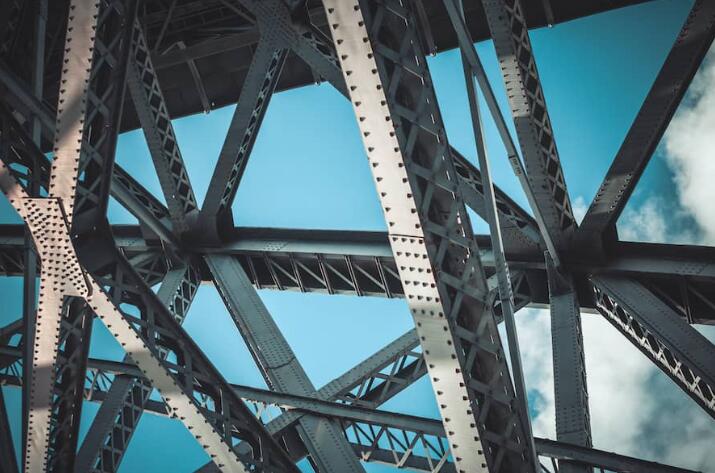Stainless steels are preferred for their superior corrosion resistance. Its derivatives are formed by altering composition of the various alloying elements. They are broadly divided into- austenitic, ferritic, martensitic, duplex and precipitation hardened stainless steels. This article will focus on the brief history, classification, properties and applications of Duplex Stainless steel.

Figure. Duplex stainless steel used in bridge construction.
Duplex stainless steels have a two-phase micro structure of austenitic and ferritic steels. Mechanical properties of duplex stainless steel depend on the relative amounts of ferrite and austenite forming elements present in the composition. Main alloying elements (other than iron) for the most popular 2205 grade are Chromium (21 -23%), Nickel (4.5 – 6.5%) and Molybdenum (2.5- 3.5%).
In this article, you will learn about:
● The properties of duplex stainless steel
● Duplex stainless steel grades
● Duplex stainless steel applications
● Future trends of duplex stainless steel
Duplex Stainless Steel grades have corrosion resistance properties equivalent or even superior to that of austenitic grades. Higher Chromium content paired with Molybdenum impart it higher resistance to pitting and crevice corrosion. Pitting Resistance Equivalent Number (PREN) is used to rank the grades based on their resistance to pitting. Higher the PREN number, higher will be its resistance to pitting corrosion.
Austenitic grades are susceptible to SCC whereas ferritic grades have higher resistance to it. Duplex Stainless steels have better SCC resistance compared to austenitic grades but inferior to ferritic stainless steel grades. In duplex stainless steel grades SCC initiates in austenitic region but is arrested at ferritic crystal structure present at the boundary, thus preventing propagation of crack and increasing uptime.
Duplex Stainless steels have higher mechanical strength than austenitic grades and ferritic grades. It permits use of thinner sections and helps in weight reduction. Machining of duplex stainless steel is difficult and slower compared to austenite, owing to its higher mechanical strength.
Welding is difficult compared to austenite. Close control on heat input and cooling rate is required in order to avoid formation of undesired intermetallic phases.
● Higher strength permits use of thinner gauges which is useful when lighter fabrications are desired
● Stainless steel prices are based mainly on one particular commodity i.e. Nickel. Duplex stainless steel have relatively low Nickel content, thus making it immune to commodity price fluctuations.
Both the above factors make Duplex stainless steel relatively cheaper with superior properties for specific applications.
| Grades | Forms |
| 1.4462 (F51 & F60) | Round bars, Billets & Ingots |
| 1.4410 (F53) | Round bars, Billets & Ingots |
| 1.4501 (F55) | Ingots |
| 1.4821 | Round bars, Billets & Ingots |
| 1.4460 (329) | Round bars, Billets & Ingots |
| 1.4362 (2304) | Round bars, Billets & Ingots |
Due to the limitations of duplex stainless steels such as poor formability and machinability, in addition to their highly complicated metallurgical process of production compared to ferritic, austenitic and martensitic stainless steels, duplex steels are used mostly for niche applications.
Applications of duplex stainless steels take into account their limitations and advantages, but the major applications require corrosion resistance, such as pitting and crevice corrosion resistance, stress corrosion resistance, fatigue corrosion, abrasion corrosion or resistance to corrosive environments that are acidic or caustic. Some of the common industrial applications are outlined below.
Duplex stainless steels are preferred to austenitic and ferritic stainless steels for the fabrication of vessels that contain bleach and other corrosive liquids in paper processing.
Desalination of seawater, a process that presents highly corrosive chlorine in a high-temperature environment, is a sturdy test for a corrosion-resistant material. Duplex stainless steels have become the material of choice for the fabrication of evaporators. They can also be made with thinner cross-sections because of the higher strength and corrosion resistance of duplex stainless steels.
The development of duplex stainless steels with PRE numbers above 40 has made it possible to manufacture components such as pumps, piping and manifolds that require high resistance to pitting and crevice corrosion, which are crucial in the oil and gas industry.
Duplex stainless steels are used in the construction of load-bearing members that also require corrosion resistance. Typical applications include the construction of bridges over seawater or structures that are in close proximity to the sea.
Lean duplex steels show promise in the commercial storage of food and drinks during processing due to their relatively low cost while retaining excellent corrosion resistance and strength.
New grades of duplex stainless steels are still being developed till date. The main driver of this endeavour is to further increase pitting corrosion resistance and this is achieved mainly by increasing key alloying elements such as chromium, molybdenum and nitrogen. The advantages of these increased alloying elements also come with disadvantages, mainly the destabilization of the ferrite phase, leading to unwanted precipitates. The challenge is to strike a balance between desirable properties mainly led by increased pitting corrosion resistance while limiting the production of undesirable intermetallic phases such as Cr2N by very precise heat treatment. A duplex steel grade, SAF 2707 HD, a 27Cr-7Ni-5Mo-0.4N with PRE-number of almost 50 has been developed, which is promising for the future of duplex steels in general.